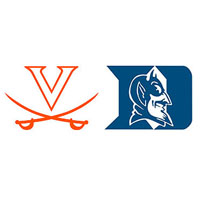
College GameDay was in town. That Virginia team was 19-0; this one is 20-1.
The game was on a Saturday, with the next game on the road at Carolina.
(That Carolina team was 17-5; this year’s is 18-4.)
That Duke team was reeling a bit, though: a modest 4-3 in the ACC, coming off a loss earlier in that week at Notre Dame.
The roster, of course, featured one-and-dones who, to that point, were looking like the 2013-2014 Dukies that had bounced out in the first round of the NCAA Tournament.
Virginia led by 11 midway through the second half, but Duke went bonkers in the last five minutes, scoring 22 points on its last eight offensive possessions, and won, 69-63.
I remember watching the Duke team running down the tunnel from the floor to the locker room in the bowels of JPJ after the final buzzer.
They had the look of a team that knew that it had just done something special.
Duke went 17-1 the rest of the way, losing only to Notre Dame in the ACC Tournament semifinals, en route to the surprise national title.
Round 2
This Duke team … isn’t that one. The talent is better, and that’s saying something, but we didn’t know then that Jahlil Okafor, Justise Winslow, Tyus Jones, were only going to be marginal NBA talents.
We are pretty sure, because ESPN tells us, every five minutes, that Zion Williamson is the Second Coming, and that R.J. Barrett, he ain’t bad.
You kind of feel bad for Cam Reddish, because nobody talks about him, but we’re told he’s going to be a lottery pick.
Somehow, this Duke team has lost twice – Gonzaga out in Maui, and Syracuse, in Durham, but, write that off, because Tre Jones was out, and Reddish was sick.
Unlike back in 2015, we’ve already seen these two teams face off, Duke winning, 72-70, notably without Jones, though his absence may have been a bit of a boost, in that it led to coach Mike Krzyzewski using Barrett at the point, and going all iso with the offense.
Iso ball is so early 2000s in a game theory sense, but when it comes to trying to attack the Virginia Pack Line, it gives you as good a chance as anything else you can try.
The Pack Line can take away your pick-and-roll game, for instance. Dump the ball into the post, and you get a post-to-post double for your trouble.
With Barrett at the point, Duke was able to spread the floor to create driving lanes for Barrett and Williamson, who, not coincidentally, had career games: Barrett scoring 30, on 11-of-19 shooting, Williamson throwing in 27, on 10-of-16.
The rest of the team had 15 points and shot 5-of-16 from the floor; Duke had six assists on its 26 made buckets; and it didn’t matter, because, W.
Where Duke missed Jones was, obviously, on the defensive end.
Virginia also played against type and spread the floor on offense, with more iso ball than you will ever see from a Tony Bennett-coached team.
And it worked: the ‘Hoos were 21-of-28 on shots in the paint, 25-of-36 overall on two-point attempts, and got plenty of nice looks on kickouts to spot-up shooters from three.
Problem, though: the good looks from three didn’t go down.
Virginia, 39.5 percent from three on the season, shot just 3-of-17 from long-range in Durham.
Coach K was able to use the bricklaying against UVA down the stretch, mixing in some zone to take away the dribble penetration.
The Cavaliers shot just 4-of-15 from the floor in the final 9:34 in a game that they would go on to lose by two.
Obviously, make even one of those missed open threes, you win, but more so, make them early, and Duke doesn’t go zone to take away the dribble-drives, at the risk of leaving guys open for knockdown threes, and that whole final 10 minutes plays out differently.
Breakdown
It’s hard to get a handle from the outside looking in how Round 2 will play out, with Jones as the X factor. Duke on offense will be different, and, credit due, Jones is a good traditional point guard, averaging 5.5 assists and just 1.2 turnovers per game.
He can be a bit of a liability if opponents sag off and make him shoot the ball – he shoots just 28.2 percent from three and 44.3 percent from the floor overall.
Jones has a reputation of being a defensive stopper, but his defensive rating, per sports-reference.com, is just OK – 92.0, worst among the Duke rotation guys.
He gambles a bit, which can be feast-or-famine: you get the steal, or you give up the blow-by.
And bigger guards – think, Ty Jerome, all 6’5” of him – can take advantage of the 6’2” Jones in the paint.
Jones makes Duke faster on both ends. Barrett moves off the ball and can attack more freely, though he didn’t seem encumbered in that respect in Round 1.
Reddish … is an enigma either way.
Which gets us to Williamson. My colleague, Zach Pereles, has an exhaustive breakdown on how UVA might best approach defending Williamson, and I won’t try to compete with what he’s done, because it’s good.
I’ll approach the Williamson issue from an outside-the-box perspective. In terms of the rotation, I think the best approach is to make Williamson work on the defensive end, and the best way to do that is to make him chase.
Bennett has been going four-guard for roughly 76 percent of UVA’s minutes this season, so it’s not like a four-guard lineup is a new wrinkle just for Duke, but it’s something that can work, and you could say that it worked with respect to Williamson in Round 1.
Yes, he did his damage, the aforementioned 27 points, 10-of-16 shooting.
You might not have noticed that he didn’t score in the last 4:50, and was visibly spent in the last five minutes, contributing only a single rebound and missing a crucial pair of free throws in the final minute.
He also blocked just one shot, a function of him being pulled out from under the basket chasing a guard more than he would be checking a big in the post, resulting in him being away from the basket from a rim-protection standpoint.
The more he has to match up with De’Andre Hunter, the more he is opposite Braxton Key, the more Mamadi Diakite, when he’s in the traditional three guards/two forwards lineup for Bennett, can pull Williamson away with faceups and pick-and-pops, the better things will work out for the good guys.
Other X factors: Jerome, Clark
We have no idea on whether Jerome will be at full strength, make a cameo appearance, hasn’t been doing anything in practice, anything, which, fine with me.
Coach K was similarly noncommittal about the status of Jones going into Round 1, his prerogative, same as Bennett can keep his cards close to his vest this week.
As was the case heading into Round 1, what this makes the opponent do is prepare for, in this case, what does Virginia do if Jerome isn’t available, how do they attack offensively, what does the defense look like.
I like it.
Either way, in terms of Jerome’s availability, Kihei Clark will be a bigger factor in Round 2. The 5’9” freshman got a surprising, to me, 18 minutes in the first game, 18 minutes during which he was the smallest guy on the floor, by at least nine inches.
Expect to see Clark get up to 30 minutes off the bench, even if Jerome is in the lineup, checking Jones, and allowing Jerome to move off-ball on the offensive end.
Column by Chris Graham










